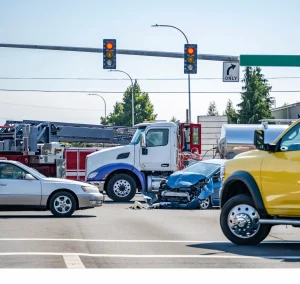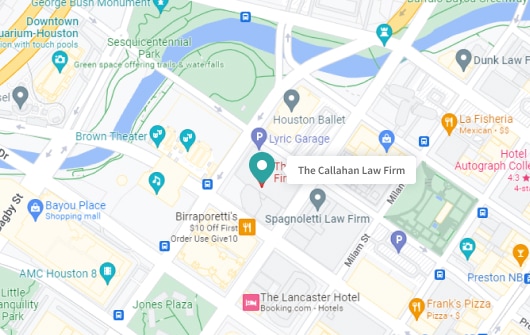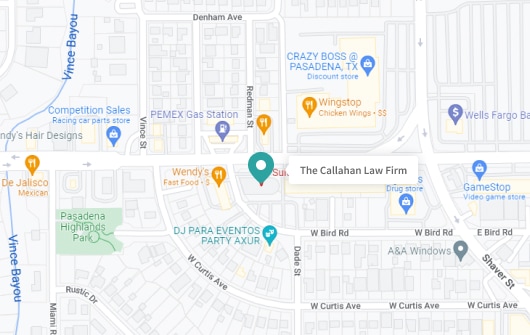How to Get Camera Footage for an Accident

Camera footage can be crucial in accident and injury cases. It provides objective visual evidence that can help establish what happened and why, who was at fault, the severity of the collision, and other key details. Having clear footage of the accident can make a major difference in determining liability and obtaining full compensation for injuries and damages.
It’s important to consult with an experienced car accident lawyer in these circumstances, as there are often legal procedures involved in accessing evidence such as video camera footage. At The Callahan Law Firm, we have the experience necessary to help you obtain important evidence that will give you the best chance for a successful claim.
If you’ve been injured by another person’s negligence, let us help you. Contact us today to schedule your no-cost consultation.
Understanding Ownership of Traffic Cameras
Traffic cameras that capture footage of roads and intersections are typically owned by local businesses and sometimes government agencies.
Most large cities and counties have an agency responsible for operating traffic cameras. You can access a list of Houston traffic cameras through the Texas Department of Transportation’s website or by contacting the DOT directly. If a specific camera is not listed or recorded by the DOT, it likely belongs to a private contractor.
Local businesses near the location of the crash often have surveillance cameras that can capture the crash or some part of it – whether a speeding vehicle, a car running a red light or stop sign. Also, contractors install and maintain traffic camera networks for cities and counties. While privately owned, the footage from these cameras may still be accessible through an official request or subpoena.
The Role of an Attorney
Having an attorney assist you in obtaining camera footage is crucial in accident cases. An experienced lawyer has the knowledge to navigate the legal process and ensure you get the evidence you need.
First, an attorney can send official requests to access any traffic camera footage that may have captured the accident. They will know who to contact and what documentation to provide, how to properly request information, and they can issue subpoenas to obtain the footage when necessary.
Additionally, your lawyer can review any camera footage that is acquired. They can analyze the video to determine what it shows and how it helps establish liability in your accident case.
Having a lawyer handle obtaining camera footage removes this burden from you; they perform the required legal legwork, freeing you to focus on your recovery.
Steps to Gather Camera Footage
Gathering camera footage after a car accident is a critical step in documenting the incident, supporting your version of events, and establishing liability. Here’s what you should do and consider:
Immediately After the Accident
It is crucial to document the location of any potential traffic cameras at the scene of the accident. As soon as it is safe to do so, take note of local businesses, residences and to the extent possible the location of any cameras and the directions they are facing. If possible, take photos or video that clearly capture those businesses or residences, as well as locations of cameras relative to the vehicles involved in the collision.
Be sure to write down cross streets, landmarks, business names, or any other details that can help pinpoint the exact spots where cameras are installed. If the police arrive and conduct an investigation, they will document some of this information that will help to locate camera footage.
Contacting the Relevant Authorities
After an accident, contacting the transportation department or government agency responsible for the traffic cameras in the area can be an important first step. This can be the local department of transportation, highway authority, or police department.
When you contact them, provide the precise location and time of the accident, as well as any camera locations you were able to identify. A proper letter citing the Texas Public Information Act and including this information should be sent when appropriate.
It’s important to act quickly when contacting the authorities, as traffic camera footage is often deleted within a short time frame. The sooner you can submit your request, the more likely it is that the footage will still be available. Having an attorney assist you can help ensure proper protocols are followed and paperwork is correctly filed.
Obtaining Camera Footage from Businesses and Residence Owners
If the camera involved in the accident is owned and operated by a business or residence owner rather than a government agency, obtaining the footage may require legal action. Business and private individuals are not obligated to voluntarily provide records, even if an accident occurred.
In these cases, it’s helpful to have a lawyer involved who can make contact, send appropriate letters, and when necessary subpoena the camera footage, which involves filing an appropriate legal action and even obtaining a court order to preserve and produce the camera footage.
An experienced lawyer will know the proper procedures for requesting and obtaining records including video footage based on the laws in your state.
The Importance of Camera Footage in Accident Cases
Camera footage serves as a reliable source of evidence in accident and injury cases. Unlike eyewitness testimony, the footage provides an objective record of the collision. The camera doesn’t blink or get facts confused – it captures events as they happen.
Footage can help prove or disprove many important details in an accident case. For example, camera evidence can show:
- The exact number of vehicles involved in the collision.
- The timing and sequence of events leading up to the crash.
- How fast the vehicles were traveling before impact.
- The amount of damage sustained in the accident.
- The direction the cars were moving when they collided.
- Any traffic violations committed prior to the crash.
Camera footage may be used as evidence in any lawsuit or trial related to an accident. If the footage clearly shows one party violating traffic laws or driving recklessly, it can be used to demonstrate that party’s liability. By providing visual proof of these details, camera footage eliminates guesswork.
Accident Reports and Camera Footage
Obtaining an official accident report from the authorities is crucial after a collision. This report contains vital information about the accident, such as the date, time, location, vehicles involved, witnesses, injuries, and more.
The accident report can be used in conjunction with any camera footage obtained to strengthen your claim for injuries and damages.
Having both an accident report and camera footage creates a more compelling case by combining authoritative documentation with irrefutable video evidence.
What to Do After a Car Accident
If you are involved in a car crash, it is important to follow proper protocol at the scene right after the accident and move forward. Here are some key guidelines to keep in mind:
- Remain at the scene of the accident. Leaving can be considered a hit-and-run, which can result in serious legal consequences. Only leave if there is a safety issue or you need medical assistance, after the police arrive and permit you to leave, or if all involved agree to leave the scene after exchanging information.
- Check on the other parties involved to see if anyone is injured. Provide aid if possible, but avoid moving injured people unless absolutely necessary.
- Call the police and report the accident. Cooperate with any law enforcement investigation of the scene.
- Document the accident scene. Take photos of vehicle damage, skid marks, debris, road conditions, and any other relevant evidence.
- Exchange insurance and contact information with the other involved parties. Get their name, address, insurance details, driver’s license number, license plate, etc.
- Obtain witness contact information. Any witnesses to the accident can provide statements to help determine fault.
- Seek medical attention even for seemingly minor injuries, as they can worsen over time. Keep records of diagnoses, treatment, and expenses.
- Contact The Callahan Law Firm. This can be a crucial step after a car accident, especially if the incident involves injuries, significant property damage, or disputes over fault. Reach out to a personal injury lawyer as soon as possible.
Following these guidelines can help protect your rights after an accident.
How Legal Professionals Can Help
Legal professionals play an important role in the aftermath of car accidents, guiding injured parties through the legal process, negotiating claims, and protecting their rights. If you’re wondering how to obtain video camera footage after an accident, contacting a lawyer is your best bet. Their experience is especially vital in securing camera footage, which plays a key role in establishing fault and supporting your claim.
From the initial case evaluation to the resolution, a lawyer will prepare and manage the claims and legal process ensuring that the injured party’s rights are protected. Through communicating with insurance companies and, when necessary, filing a lawsuit and preparing the case for trial, an experienced car accident lawyer will work tirelessly to achieve the best possible outcome. Their support allows their clients to focus on their recovery, knowing that the case is being handled by a dedicated professional committed to their well-being and full justice.
Take Action: Contact The Callahan Law Firm Today
Ultimately, the role of a lawyer in car accident cases is invaluable, offering guidance through the challenging aftermath. The attorneys at The Callahan Law Firm will help with all aspects of your case, including securing critical evidence including video footage when available and representing you through resolution of the claim.
Don’t navigate the aftermath of a car accident alone. Reach out to The Callahan Law Firm today to schedule a no-cost consultation with a car accident lawyer.
FAQ:
How do I request traffic camera footage in Texas?
First, you must understand the layout of the crash scene including the location of nearby businesses, residences and possibly traffic cameras. To request traffic camera footage from a governmental authority in Texas, contact the Texas Department of Transportation (TxDOT) or the local government agency responsible for the area where the incident occurred. Submit a formal PIA request detailing the date, time, and specific location of the footage needed. If the camera is owned/operated by a private individual or you’re having difficulty getting the footage, reach out to a lawyer as soon as possible.
How long is traffic camera footage stored?
It depends on whose camera recorded the event, and their policies for preserving the footage. Traffic camera footage storage periods vary – it could be 24 hours, a week, a month or some other time period. That’s why it’s important to determine what camera footage might exist and then properly request it as soon as possible after the incident.

Michael S Callahan is an attorney and founder of The Callahan Law Firm. He focuses his practice on representing individuals and families in personal injury cases involving motor vehicle and truck accidents, workplace accidents and defective products. With over 25 years of experience, he is dedicated to fighting on behalf of people whose lives have been forever altered by the negligence and carelessness of corporations and individuals. Originally trained as a mechanical engineer, Michael has been practicing law and fighting for justice for those who need it most since 1994. He is board-certified in Personal Injury Trial Law by the Texas Board of Legal Specialization and a member of various esteemed legal associations. Outside of work, Michael enjoys spending quality time with his family, outdoor activities, and continually striving to improve as a trial lawyer and human being.











